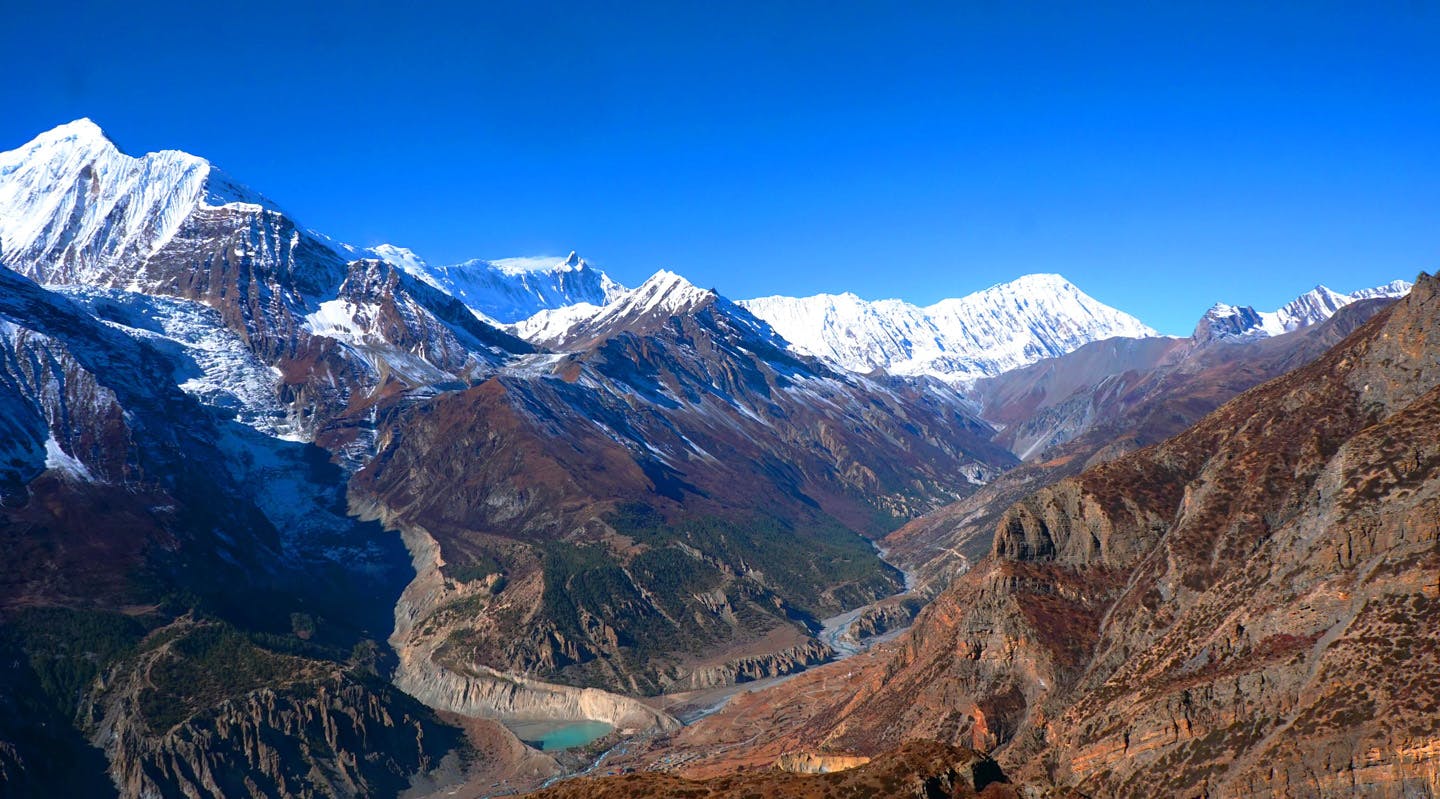
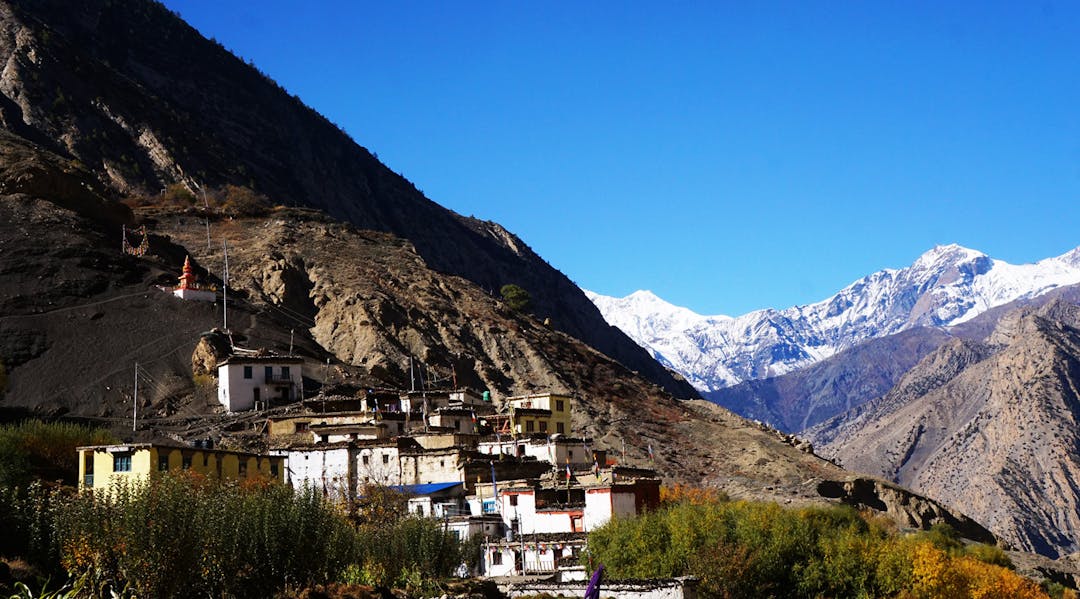
Lower Mustang trek is a great option if you're short on time but still wish to experience the stark beauty of the deep Himalayas and Tibetan culture. Mustang is known as geographically Nepal and culturally Tibet. You'll take a moderate trek through the region bordering Annapurna and Mustang with great views of Annapurna and Dhaulagiri. Mustang is part of an ancient trade route to Tibet, up the Kali Gandaki River, and offers one of the most developed trails with comfortable teahouses run by Gurung and Thakali families. The deep valleys and steep mountains surrounding the giant Mt. Annapurna embrace a wide range of landscapes, from subtropical jungle to the high-altitude desert of the Tibetan Plateau. Apart from the scenery, this is a pilgrimage route for Hindus and Buddhists. Mustang is known for its unique cultural experience, pilgrimage, and spirituality as well.
This trek provides a breathtaking panoramic view of Mt. Dhaulagiri, Annapurna, and Tibetan landscapes and eliminates the need for acclimatization. The scenery remains stunning throughout the journey, not just at the final destination. If you are looking for something more about Tibetan Buddhism, spirituality, and Tibetan landscapes then this is the ideal choice for you. Observing local activities up close, witness festivals and rituals. The diverse cultural mix and the surrounding environment add to the trek's allure. With an easy terrain and moderate elevation, the trek is suitable for everyone. In case of emergencies, transportation is readily available from each overnight stop. Accommodations are well-developed, offering a variety of food options along the entire route. While basic health facilities like health posts, pharmacies, and consultants are available, this trek is particularly recommended for its accessibility and unique experiences. If you have alternative trek preferences or specific destinations in mind, feel free to share, as we are eager to tailor your trip and welcome you to Nepal.

The Langtang Valley Trek is situated within the Langtang National Park and is regarded as the third Most Popular Trek in the Nepal Himalaya, following the Annapurna Circuit and the Everest Base Camp trek. This valley, running from east to west, provides stunning alpine landscapes and a wonderful opportunity to encounter the unique Tamang people. The locals here adhere to Tibetan Buddhism and speak the Tibetan language, distinguishing them from the Tamang people in the lower regions.
Upon crossing the narrow valley along the Langtang River, we enter the main valley, surrounded by towering peaks such as Langtang II (6571m), Langtang Lirung (7246m), Yansa Tsenji (6543m), Yala Peak (5500m), Morimoto (6750m), Langtang Ri (7205m), Dorje Lakpa (6966m), Karpo Ri (6830m), Langshisha Ri (6370m), Gang Chhengpo (6388m), Ponggen Dopku (5930m), and several others. Kyanjin Ri (4773m), Tserko Ri (4984m), and Langshisha Kharka are the recommended side trips and viewpoints along the journey.
While a minimum of one week is necessary for the trek, trekkers should allocate additional days for acclimatization and exploring side attractions within the valley. Before your trip starts your guide would be brief about the trip shortly, this will be the pre-trip meeting for you, so please make sure that you ask all the questions.
Autumn and spring season are the best season for trekking in Langtang Region. Summer might be a unique experience but lots of hassle because of rain . The heavy rain may affected the some part of trekking and transportation in summer.
Winter is cold and dry. However no risk of avalanche. This trek is perfect for winter-less trekkers and quietness. The trekking route is always open and has an availability of hotels. For correct information keep consulting with us and your guide about the situation of the route and places.
Note that if you like to visit in the low season like summer or winter just plan a few more extra days just in case.
About the weather check yourself Here and consult with our expert. For more please visit our page Best trekking season in Nepal.
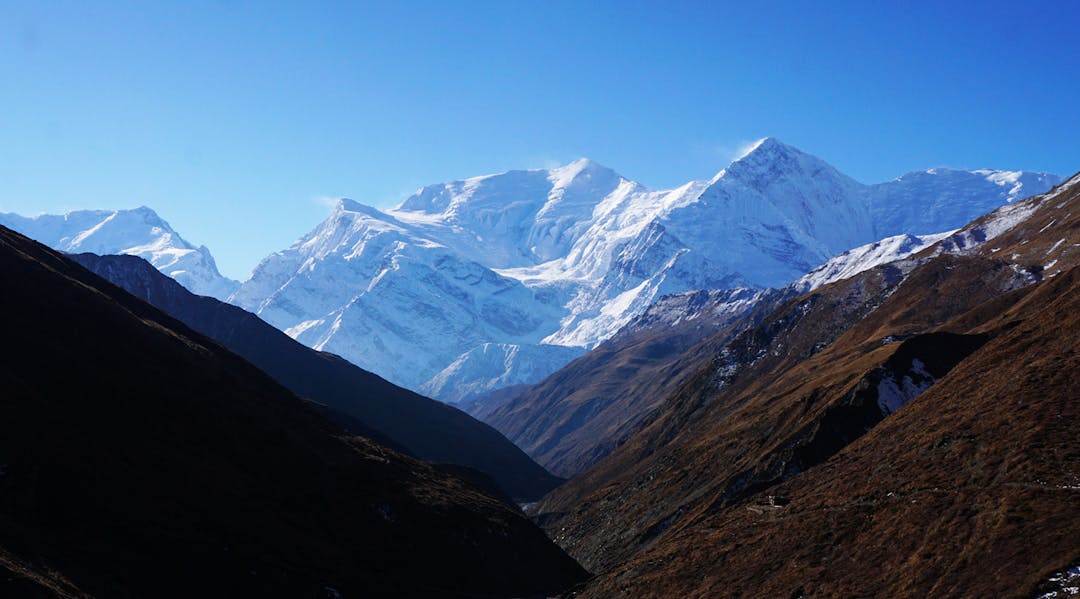
Nestled in the breathtaking Annapurna Region and Annapurna Circuit Trek of Nepal, the Manang Trek stands as a testament to the mesmerizing beauty of the Himalayas. Embark on an unforgettable adventure through the awe-inspiring landscapes of the Annapurna Circuit with the charming Manang Trek. This renowned Himalayan journey takes trekkers on a mesmerizing journey through the heart of the Annapurna Massif, offering panoramic views of towering peaks. For those who looking for less adventurous and have limited time we recommended Manang Trek to explore the Manang valley, the Tibetan landscape, the close-up mountain view of the Annapurna range with other several peaks with glaciers, local people Manage (Gurung), culture and their traditions, Gumbas, Monastry, lake, stupas, caves and many more.
The Manang trek is not only a visual delight but also a cultural immersion into the lifestyles of the local communities. Trekkers have the opportunity to interact with the hospitable inhabitants of Manang, explore ancient monasteries, and witness the daily rituals of the Gurung and Manangi people. With its unique combination of natural beauty, cultural richness, and physical challenge, the Manang trek stands as a must-explore destination for those seeking an unforgettable adventure in the heart of the Himalayas. So we designed this Manang Trek for everyone who always have been dreamed of exploring the Himalayas.
This trek provides a breathtaking panoramic view of Annapurna from base to summit, eliminating the need for acclimatization. The scenery remains stunning throughout the journey, not just at the final destination. Observing local activities up close, there's a chance to witness festivals and rituals. The diverse cultural mix and the surrounding environment add to the trek's allure. With an easy terrain and moderate elevation, the trek is suitable for everyone. In case of emergencies, transportation is readily available from each overnight stop. Accommodations are well-developed, offering a variety of food options along the entire route. While basic health facilities like health posts, pharmacies, and consultants are available, this trek is particularly recommended for its accessibility and unique experiences. If you have alternative trek preferences or specific destinations in mind, feel free to share, as we are eager to tailor your trip and welcome you to Nepal.

Everest Base Camp Trek is not a complete circuit trek of the Khumbu Region. However, it includes many popular destinations like EBC, Kalapather, Cho-la Pass, Gokyo Lake, Gokyo Ri, and Renjola pass (in option) of Everest region. The maximum elevation of this trek is 5648m. And most of the time, we trek over 4000m from the sea level. The trial difficulties are medium to hard. Uphill before Namche Bazar, Tangboche, Kalapatter, Chola- Pass and Gokyo Ri makes this trek hard. Most of the time the trials gradually climb up. Verities of food and accommodation are available here. This trial goes the heart of the Khumbu region with more than 25 mountains over 6000m and 3 mountains more than 8000m including ‘Highest Peak Of The World Everest’, ‘High Altitude Lakes’, ‘Sherpa People their Culture’, ‘Religion and Spirituality’, ‘High Altitude Settlement Their Activates and Lifestyle’.
This trek is approx. 132 km long journey in the alpine Himalayas with 10 km on average per day. The fitness preparation should be done before the start of trekking. The itinerary is carefully guided by safety regulations and medical recommendations. In case of emergency, helicopter evacuation is possible. I would like to request you that do not worry about High Altitude Sickness we will take care of it. This is the customized itinerary for you after evaluating the fitness and experience of many clients in high-altitude regions.
Why to trek at Everest Base camp
Sagarmatha Nation Park “World Heritage Site”
Sagarmatha National Park is a protected area located in the eastern part of Nepal. It was established in 1976 and covers an area of 1,148 square kilometers (443 square miles). The park is named after Sagarmatha, which is the Nepali name for Mount Everest, the world's highest peak.
Sagarmatha National Park is not only a destination for adventure seekers but also a place of cultural and ecological importance, contributing to the global understanding and appreciation of the Himalayan region.
Sherpas
Sherpa, known as the 'People from the East,' form an ethnic group that migrated from eastern Tibet around five centuries ago. Originally nomadic, they traversed the rugged terrain with their yaks, moving between pastures in Tibet and wintering in Nepal. Engaged in cross-border trade prior to 1959, Sherpa were involved in the exchange of various commodities, including yaks, butter, Jhoppa (a crossbreed between a male cow and yaks), cement, carpets, noodles, and salt. This trade activity showcased their resourcefulness and adaptability.
Living in the Khumbu region, Sherpa communities maintain the highest permanent settlements globally, reaching altitudes of up to 4700 meters. In the early 1900s, Sherpa individuals transitioned into roles as high-altitude expedition porters and guides, earning the mark "Tigers Of The Snows" for their skillful climbing skills in challenging environments.
Along with their contributions to trade and mountaineering, Sherpa brought their rich religious, cultural, and traditional practices to the regions they inhabited. Their deep-rooted belief in Tibetan Buddhism is a keystone of their way of life, influencing their values and shaping their communities over centuries. Sherpa communities remain integral to the cultural wall-hanging of the Himalayan region, embodying a unique blend of tradition, and spiritual beliefs.
In contemporary times, Sherpa people have become synonymous with mountaineering and trekking brands. They have diversified into various businesses, extending their influence globally. Renowned for their courage and honesty, they are recognized as some of the world's most fearless and trustworthy individuals.
Name and Meaning after Mt. Everest
Mount Everest got its name from the British who named it after Sir George Everest. However, it has various names in different local languages. The Sherpa and Tibetan people call it Chomolungma, which means 'Mother Goddess.' This name comes from Jomo Miyo Langsangma, recognized by the Sherpa as one of the five sister mountain goddesses linked with agricultural abundance. In Nepali, the name is Sagarmatha, translating to 'Forehead of the Sky.' In Chinese, it is known as ‘Zhumulangma’, adopting the local name
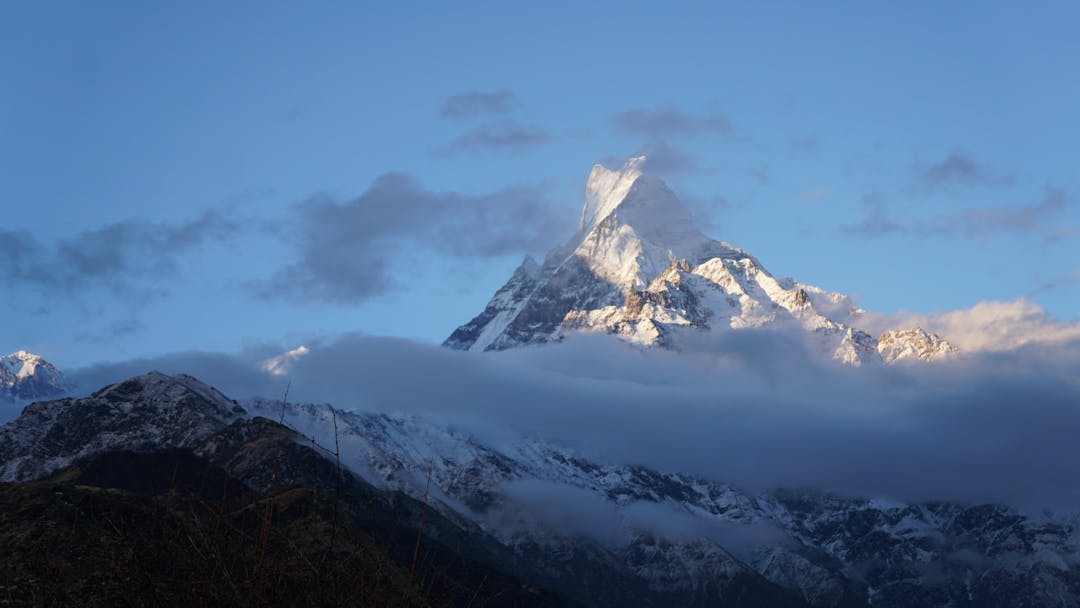
Mardi Himal Trek is considered a short and easy Treking in the Annapurna Region. It is famous among Nepali trekkers. It is because of easy climbing and extraordinary views from the beginning. Lush green forest, 360-degree view, closet yak husbandry, and local activities are attractions of this trek. The maximum altitude of the trek is up to 4500 m at the Mardi Himal Base Camp. The panoramic view of the mountains is Annapurna South (7219m), Machhapuchhre (Fishtail) 6993m, Himchuli (6441m), Annapurna III (7555m), Glacier Dome, a green lush hill and Pokhara valley. Mardi Himal is also popular for the sunrise, sunset, and cloud views. The rich flora, fauna, wildlife, the green rich forests of Oak and maple trees, and the gorgeous national flower ‘Rhododendron’ along the trails make this Mardi Himal Basecamp Trek worthy. The Mardi Himal trek is simply the best trek not only for the stunning views of the mountains but also to discover the traditional village, Gurung people, and the true countryside of Nepal.
• Easy terrine and Close to Pokhara City
• Spectacular high mountain view of Annpurnas, Mt Fishtail(Machhapuchhre) and valley in one glance
• Lush Forest and wildlife
• Gurung People, Mix culture and homestays
• Organic Tea Garden and Tea factory
• Everyday 360 view of the mountain
• View of Pokhara Valley and lower hilly region
• Rhododendron forest and Flowers in Spring
• Nepali National Bird Danfe and Munal
• Spectacular Sunrise and Sunset every day
• Flora and fauna
• Yak and Sheep husbandry and grazing land
• Low risk of High Altitude sickness


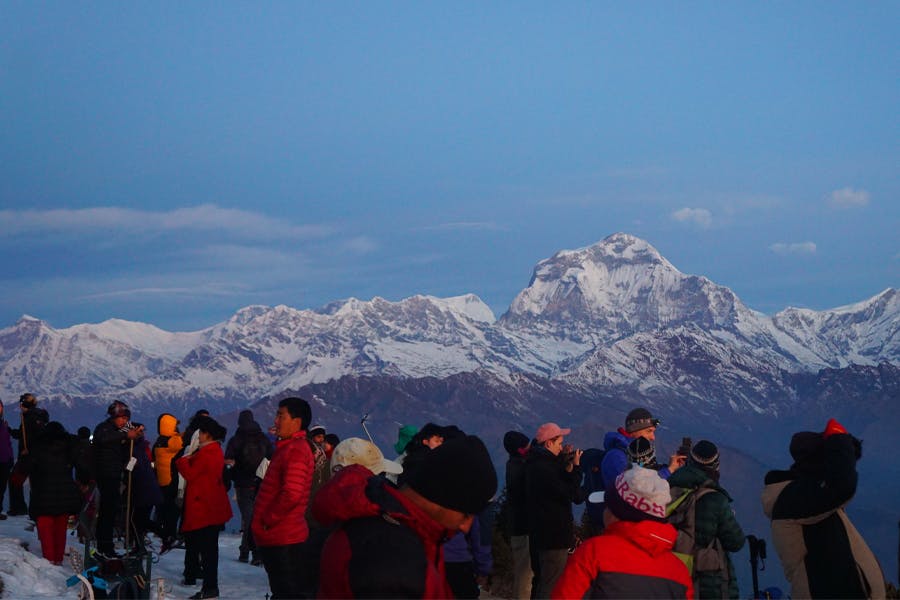
Poonhill Trek is one the most famous, short, and easy treks of the Annapurna Region. The main attraction of this trek is the Poonhill (3210m) viewpoint from where you can see breathtaking views of 25 mountains with 3 mountain ranges Dhaulagiri 8167m, Annapurna8091m, and Manaslu 8163m and the 3 Highest Mountains in the world. Poonhill is one of the best destinations to see sunrise/ sunset and a close-up 360-degree Mountain View. Walking in dense rhododendron forests and witnessing springs and waterfalls is the best lifetime experience of Poonhill Trek. The local people of Ulleri and Ghandruk villages, their pattern of lifestyle, and the structure of households are different and fascinating.
Before Trekking starts:
After you arrive at the Hotel your guide will brief you about the trip shortly, this will be the pre-trip meeting for you, so please make sure that you ask all the questions.
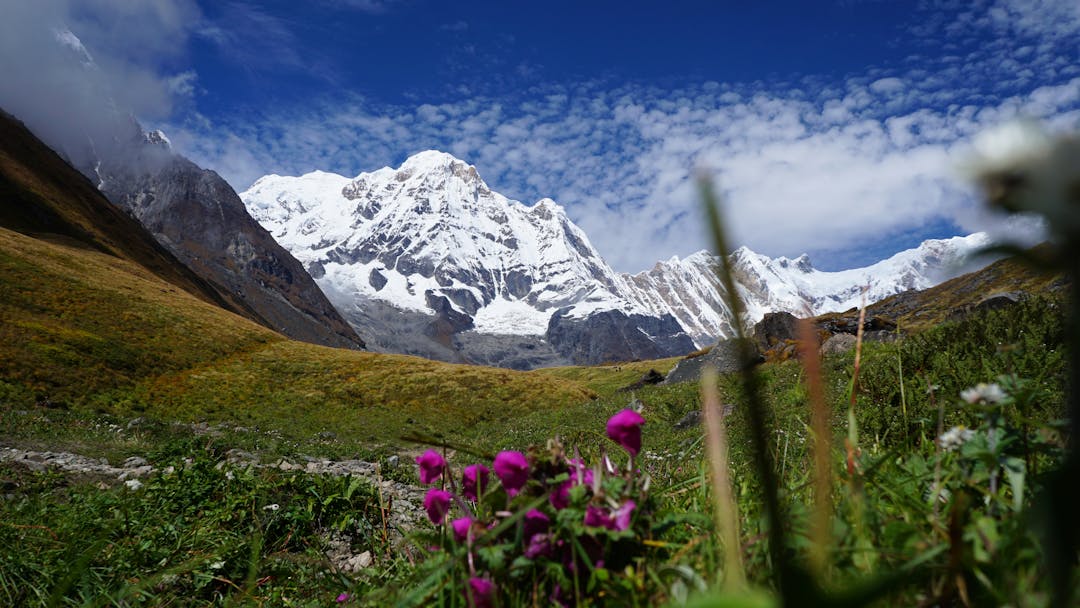
Annapurna Base Camp Trek is a spectacular short trek with a huge variety of terrain, from rice terraces to glacial moraine. Annapurna Base Camp Trek also known as Annapurna Sanctuary trekking. It offers outstanding High Mountain views of Annapurna I(8091m), Tent Peak(5695m), Glacier Dome(7193m), Gangapurna (7455m), Annapurna III (7555m), Machhapuchhre (6993m), Hiuchuli (6444m) & Annapurna south (7219m) along with 360 degree view in the valley. Annapurna Basecamp has a fine close-up Mountain View without acclimatization day. The maximum elevation of this trek is 4130m from the sea level.